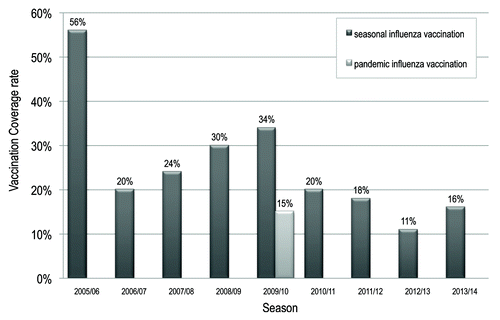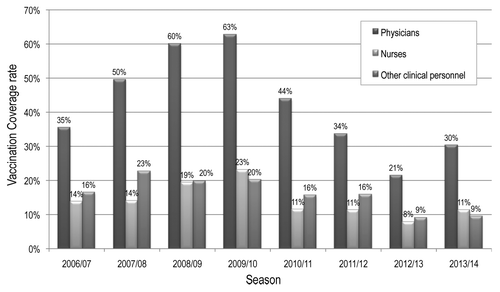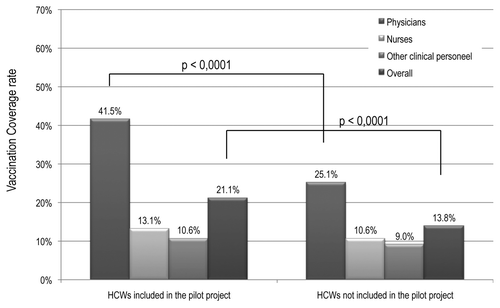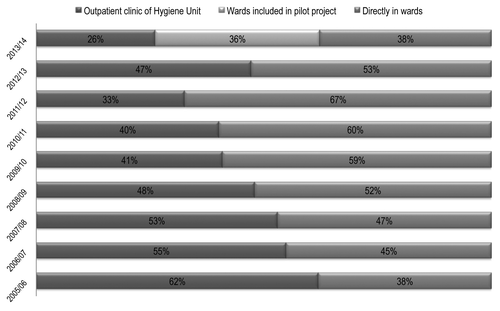Abstract
Influenza vaccination is a fundamental tool for the prevention of influenza in healthcare settings and its administration to healthcare workers (HCWs) is recommended in more than 40 countries including United States of America and many countries of the European Union. Despite these recommendations, the compliance of HCWs to influenza vaccination is largely inadequate in Italy. Since 2005/06 season, a comprehensive multifaceted intervention project aimed at increasing the seasonal influenza vaccination coverage rates among HCWs was performed at the IRCCS AOU San Martino IST teaching hospital in Genoa, Italy, the regional tertiary adult acute-care reference center with a 1300 bed capacity. Despite almost a decade of efforts, the vaccination coverage rates registered at our hospital steadily remain unsatisfactory and very distant by the minimum objective of 75% defined by the Italian Ministry of Health. During the last influenza season (2013/14), vaccination coverage rates by occupation type resulted 30% among physicians, 11% among nurses and 9% among other clinical personnel.
Further efforts are necessary to prevent the transmission of influenza to patient and novel strategies need to be identified and implemented in order to increase the compliance of HCWs, particularly nurses, with the seasonal influenza vaccination.
Keywords: :
Introduction
Seasonal influenza represents a major public health problem causing, each year, an increase in hospitalizations due to its complications and a substantial mortality.Citation1 Healthcare workers (HCWs), such as doctors, nurses and other health professionals may have substantial rates of clinical and sub-clinical influenza during influenza seasons and may transmit influenza to patients, many of whom have serious underlying conditions that increase the risk of complications.Citation2 Influenza illness in vulnerable patient populations, such as bone marrow transplant recipients or intensive care unit patients, can result in devastating consequences, with severe, prolonged, and often fatal disease.Citation3 Even among patients on general adult and pediatric wards, healthcare facility-acquired influenza can determine an increased length of hospital stay and added costs for testing and treatment.Citation3
For these reasons, influenza vaccination is a fundamental tool for the prevention of influenza in healthcare settings and its administration to HCWs is recommended in more than 40 countries including the United States of America (US) and many countries of the European Union.
In the US, to protect health care workers and their patients, Center for Disease Control and Prevention (CDC), the Advisory Committee on Immunization Practices (ACIP), and the Healthcare Infection Control Practices Advisory Committee (HICPAC) recommend that all HCWs get vaccinated annually against influenza.Citation4
In Italy, the Ministry of Health every year includes HCWs within the categories of subjects that should receive influenza vaccine in order to avoid work absenteeism during influenza season, the period with more healthcare demand, and to prevent the transmission of influenza from HCWs to patients, particularly to elderly or immunocompromised patients.Citation5
In terms of vaccination coverage rate to reach in order to optimize the control of influenza in healthcare settings, in the US the Healthy People 2020 established a minimum objectives of 90% influenza vaccination coverage rate for HCWs by 2020;Citation6 in Italy, as well as in most European countries, the minimum objective to reach with the vaccination campaign is a 75% vaccination coverage rate among HCWs and the optimal goal to reach is a 95% coverage rate.Citation5 However, the vaccination coverage rates achieved in the US and in Europe are really divergent.
An internet panel survey conducted by CDC since 2010/11 influenza season among almost 2 thousands HCWs , estimated that 72% of HCWs received influenza vaccination for 2012/13 season and vaccination coverage rate resulted 92% among physicians and 85% among nurses. Interestingly, the vaccination coverage rates steadily increased during the three seasons of surveillance.Citation7
In Europe, despite decades of efforts to encourage HCWs to be immunized against influenza, vaccination levels remain insufficient.Citation8 A recent survey reported official vaccination coverage rates collected in 10 European countries during three consecutive influenza seasons (from 2008/09 to 2010/11). The vaccination coverage rates ranged from 12%, registered in Norway and Wales in 2009/10, to 98% registered Romania in 2008/09. During season 2010/11 vaccination coverage was between 30% and 50% in England, Hungary, Portugal and Scotland. The remaining countries (France, Germany Norway, Slovenia, Spain, and Wales), with exception of Romania, reported vaccination coverage ranged between 14% and 28% in 2010/11.Citation9
The very low vaccination coverage rates across Europe have also been confirmed by a population-based cross-sectional survey carried during two consecutive influenza seasons in the UK, Germany, Italy, France, Spain, Austria, Czech Republic, Finland, Ireland, Poland and Portugal. The coverage rates were generally low and ranged from the lowest rate of 6.4% in Poland to 26.3% in Czech Republic, in 2007/08. In Italy the vaccination coverage rate was 12.2% in 2006/07 season and decreased to 10.9 in the next season, even if the difference was not statistical significant.Citation10
Based on these results, increasing the vaccination coverage rate for influenza vaccination among HCWs represents a hard but essential challenge for all European countries including Italy.
Since 2005/06 season, a project aimed at increasing their vaccination coverage rates against influenza among healthcare personnel was performed at the IRCCS San Martino, IST teaching hospital in Genoa, the regional tertiary adult acute-care reference center with a 1300 bed capacity. The manuscript summarizes the main results of this project.
Methods
A comprehensive, multifaceted intervention project based on education, promotion, and easy access to vaccination have been implemented by the medical directorate of the hospital in cooperation with the infection control team and the Hygiene Unit.
Education
Continuing education of HCWs on the burden of influenza among high risk patients and benefits and risks of influenza vaccination have been implemented during the nine seasons period within several course about hospital acquired infections and patient safety
Promotion
Promotion materials including advertising posters hanged up the time clocks every year at the beginning of the vaccination campaign, direct solicitation during the routine preventive medicine visit, letters sent to all medical directors, nursing administrators and quality managers of each department, explaining how and why the vaccine is recommended, have been used during each influenza season.
Easy access to vaccination
The hospital has given the opportunity for health-care workers to be vaccinated at the outpatient clinics devoted to this (Hygiene Unit) as well as directly in the departments they belong to, by previous request of the necessary number of vaccine doses by fax or e-mail to the Hygiene Unit clinic.
The pilot project in the high risk wards
Since 2013/14 influenza season a pilot project have been implemented in the high risk wards of the hospital where patients, because of their comorbidity conditions have more risk of acquiring influenza and to develop its complications. In particular the wards included in the project have been the hematological and oncological wards, intensive care units, geriatric, and general medicine wards, and pneumological wards.
The main objective of this project was to improve immunization coverage for influenza in the healthcare workers of high risk wards for nosocomial transmission of influenza.
Directly in each of the wards included in the project, the medical and nursing staff of the Hygiene Unit of the hospital have performed:
Vaccination counselling to health care personnel of the ward
Active vaccination offer and administration of vaccine
Collection of informed vaccination consent or dissent
Results
Since the beginning of the project, vaccination coverage rates steadily increased form 20% in 2006/07 to 34% in 2009/10 (). In the season 2009/10 when we reached the peak of 34% in seasonal influenza vaccine coverage rate, HCWs should have been vaccinated against pandemic influenza but only 15% of our staff consented to receive the monovalent vaccine. In the following three seasons, vaccination coverage rate rapidly fell to 11% in 2012/13, while during the season 2013/14, the vaccination coverage rate among health care workers increased to 16%.
Figure 1. Vaccination coverage rates among healthcare workers of IRCCS AOU San Martino, IST of Genoa during 9 consecutive seasons.

The same trend was observed among all occupation types over the eight seasons (). During the last season, vaccination coverage rates by occupation type resulted 30% among physicians, 11% among nurses and 9% among other clinical personnel.
Figure 2. Vaccination coverage rates to occupation type among healthcare workers of IRCCS AOU San Martino, IST of Genoa during 8 consecutive seasons.

With respect to HCWs involved in the pilot project, overall 929 out of 3444 HCWs working in the hospital were included in the project and 701 (75.5%) signed the vaccination consent or dissent. The vaccination coverage rates of HCWs included and those not included in the project, overall and by occupation type, are outlined in .
Figure 3. Vaccination coverage rates to occupation type among healthcare workers (HCWs) of IRCCS AOU San Martino, IST of Genoa included and not included in the pilot project.

Interestingly, the difference in overall vaccination coverage rate and in the vaccination coverage rate among physicians resulted statistical significant, while no difference were registered in vaccination coverage rates among nurses and other clinical personnel
During the project, we also observed some changes also in the setting of influenza vaccine administration. As outlined in , since the beginning of the project, a gradual and steady growth in the number of vaccinations administered in the hospital wards has been observed with a consequent reduction of the doses administered at the Hygiene Unit outpatient clinic. During the last season, 74% of HCWs were vaccinated in the hospital wards and 26% at the Hygiene Unit outpatient clinic; however, 48.6% of HCWs that received the vaccination in the ward were included in the pilot project and were vaccinated by Hygiene Unit personnel.
Discussion
Since 2005/06 season a comprehensive, work-site strategy that include education, promotion, and easy access to vaccination has been implemented at the IRCCS San Martino - IST teaching hospital in Genoa in order to increase seasonal influenza vaccination coverage rate among HCWs. Despite almost a decade of efforts, the vaccination coverage rates registered at our hospital steadily remain unsatisfactory and very distant by the minimum objective of 75% defined by the Italian Ministry of Health. The mean vaccination coverage rate in the period 2006–2013 was 21.6% ranging from 11% to 34%. The highest vaccination coverage rate of 56% registered in season 2005/06, the first year of project, probably resulted by psychological conditioning related to the risk of avian influenza, whereas, during season 2012/13, when the lowest coverage rate of 11% was registered, two seasonal influenza vaccine formulations were suspended by Italian Medicine Agency determining a shortage of influenza vaccines and raising concerns about vaccine safety.
Our data resulted in accordance with that registered in several Italian and European hospitals. During the season 2010/11, the mean vaccination coverage rates registered in 11 European countries was 29.8%.Citation9 In Italy, where no updated and official data are available, in the period 2006–2008 the mean vaccination coverage rate reported among HCWs was 11.5%.Citation10
Also the decline of vaccination coverage rates observed in the post pandemic season is consistent with the results of other studies. In Germany seasonal influenza vaccine uptake in the pre-pandemic season 2008/09 was 30.5% among HCWs and decreased to 25.8% in the first post-pandemic season 2010/11.Citation11 A similar reduction was observed in France, Hungary, Portugal and Spain.Citation9
As highlighted by other authors, the concerns about the safety, necessity and efficacy of pandemic influenza vaccination may have affected the confidence of HCWs in influenza vaccines thus contributing to decrease the seasonal vaccine uptake in the post-pandemic seasons.Citation11,Citation12
The results obtained during the last influenza season through vaccination counselling, active vaccination offer directly in the high risk wards and collection of vaccination dissent demonstrated a better compliance to vaccination among physicians, whereas no difference were registered among nurses and other clinical personnel. However, also the vaccination coverage rate of 41.5%, registered among physicians of high risk ward, remains suboptimal.
Overall, the results registered during the nine years project impose to identify and implement novel strategies to increase the compliance of HCWs, particularly nurses, with the seasonal influenza vaccination.
Continuing education focused on risk of influenza, benefits of vaccination and reinforcing reasons for vaccine acceptance as well as free and convenient access to vaccination over a prolonged period of time represent key component of influenza vaccination programs and should be strengthened even if their efficacy on reaching vaccination coverage rate objectives remain controversy.Citation13,Citation14
Visible support of institutional leadership, organization of vaccination days, gift incentives such as free food, movie tickets or health books, assignment of dedicated and specialized staff are other useful intervention components of vaccination programs.Citation14,Citation15 Interestingly, the number of interventions included in multifaceted programs seems to be associated to the increase in vaccination uptake.Citation14
A recent review focused on interventions to increase influenza vaccination among HCWs has pointed out that making influenza vaccination a mandatory vaccination strategy is the most successful method for increasing vaccination uptake.Citation14 In the past few years, several healthcare facilities in the US have implemented mandatory policies achieving nearly 100% compliance.Citation8 Although mandatory policies have met considerable resistance based on the argumentation that represent a violation of fundamental individual rights, several US professional societies recommended mandatory strategy and several studies showed support for this policy among HCWs in the US.Citation14 Unlike in the US, European hospitals have been rather hesitant to implement mandatory policies.Citation8 A recent study reported the results of a multifaceted patient safety program that combined the mandatory strategy with the HCWs’ right for vaccine declination. The program, which was associated with a vaccination rate of 96%, required all HCWs with direct patient contact to choose between vaccination and an “appropriate non-vaccine alternative,” that is, either to wear a surgical mask or to exclude patient contact.Citation16
Conclusions
In our hospital, further efforts are necessary to prevent the transmission of influenza to patient. The main objective of increasing vaccination coverage rates against influenza among the healthcare personnel can be reached through well-designed long-term intervention programs that include a variety of coordinated managerial and organizational elements. In this scenario, novel strategies such as mandatory vaccination, at least in high risk wards, should be considered and debated in order to reduce the risk of nosocomial transmission of influenza in frail patients. Furthermore, a minimum vaccination coverage rate target could be included between the budget objectives of the hospital wards’ clinical directors.
| Abbreviations, | ||
| HCWs | = | healthcare workers |
| US | = | United States of America |
| CDC | = | Center for Disease Control and Prevention |
| ACIP | = | Advisory Committee on Immunization Practices |
| HICPAC | = | Healthcare Infection Control Practices Advisory Committee |
Disclosure of Potential Conflicts of Interest
All authors declare that they have no support from any organization for the submitted work; no financial relationships with any organizations that might have an interest in the submitted work; no other relationships or activities that could appear to have influenced the submitted work.
Acknowledgements
The work was not funded.
References
- MolinariNA, Ortega-SanchezIR, MessonnierML, ThompsonWW, WortleyPM, WeintraubE, BridgesCB. The annual impact of seasonal influenza in the US: measuring disease burden and costs. Vaccine2007; 25:5086 - 96; http://dx.doi.org/10.1016/j.vaccine.2007.03.046; PMID: 17544181
- AhmedF, LindleyMC, AllredN, WeinbaumCM, GrohskopfL. Effect of influenza vaccination of healthcare personnel on morbidity and mortality among patients: systematic review and grading of evidence. Clin Infect Dis2014; 58:50 - 7; http://dx.doi.org/10.1093/cid/cit580; PMID: 24046301
- BridgesCB, KuehnertMJ, HallCB. Transmission of influenza: implications for control in health care settings. Clin Infect Dis2003; 37:1094 - 101; http://dx.doi.org/10.1086/378292; PMID: 14523774
- Advisory Committee on Immunization Practices, Centers for Disease Control and Prevention (CDC). Immunization of health-care personnel: recommendations of the Advisory Committee on Immunization Practices (ACIP). MMWR Recomm Rep2011; 60:RR-71 - 45; PMID: 22108587
- Italian Ministry of Health. Prevention and control of influenza: recommendations for the 2013-2014 season. Available from http://www.trovanorme.salute.gov.it/norme/renderNormsanPdf;jsessionid=GHZ3I4fifhZPkmcGJho0EQ__.sgc4-prd-sal?anno=0&codLeg=46769&parte=1%20&serie=.
- HealthyPeople.gov. Office of Disease Prevention and Health Promotion; US Dept of Health and Human Services. Available from http://www.healthypeople.gov/2020/topicsobjectives2020/objectiveslist.aspx?topicId=23#578825.
- Centers for Disease Control and Prevention (CDC). Influenza vaccination coverage among health-care personnel--United States, 2012-13 influenza season. MMWR Morb Mortal Wkly Rep2013; 62:781 - 6; PMID: 24067582
- WickerS, MarckmannG. Vaccination of health care workers against influenza: Is it time to think about a mandatory policy in Europe?. Vaccine2013; S0264-410X:1338-8; PMID: 24120676
- MereckieneJ, CotterS, NicollA, LopalcoP, NooriT, WeberJ, D’AnconaF, Levy-BruhlD, DematteL, GiambiC, et al, VENICE project gatekeepers group. Seasonal influenza immunisation in Europe. Overview of recommendations and vaccination coverage for three seasons: pre-pandemic (2008/09), pandemic (2009/10) and post-pandemic (2010/11). Euro Surveill2014; 19:20780; http://dx.doi.org/10.2807/1560-7917.ES2014.19.16.20780; PMID: 24786262
- BlankPR, SchwenkglenksM, SzucsTD. Vaccination coverage rates in eleven European countries during two consecutive influenza seasons. J Infect2009; 58:446 - 58; http://dx.doi.org/10.1016/j.jinf.2009.04.001; PMID: 19446340
- BöhmerMM, WalterD, FalkenhorstG, MütersS, KrauseG, WichmannO. Barriers to pandemic influenza vaccination and uptake of seasonal influenza vaccine in the post-pandemic season in Germany. BMC Public Health2012; 12:938; http://dx.doi.org/10.1186/1471-2458-12-938; PMID: 23113995
- PolandGA. The 2009-2010 influenza pandemic: effects on pandemic and seasonal vaccine uptake and lessons learned for seasonal vaccination campaigns. Vaccine2010; 28:Suppl 4D3 - 13; http://dx.doi.org/10.1016/j.vaccine.2010.08.024; PMID: 20713258
- HakimH, GaurAH, McCullersJA. Motivating factors for high rates of influenza vaccination among healthcare workers. Vaccine2011; 29:5963 - 9; http://dx.doi.org/10.1016/j.vaccine.2011.06.041; PMID: 21699950
- HollmeyerH, HaydenF, MountsA, BuchholzU. Review: interventions to increase influenza vaccination among healthcare workers in hospitals. Influenza Other Respir Viruses2013; 7:604 - 21; http://dx.doi.org/10.1111/irv.12002; PMID: 22984794
- McCullersJA, SpeckKM, WilliamsBF, LiangH, MirroJJr.. Increased influenza vaccination of healthcare workers at a pediatric cancer hospital: results of a comprehensive influenza vaccination campaign. Infect Control Hosp Epidemiol2006; 27:77 - 9; http://dx.doi.org/10.1086/500003; PMID: 16418993
- SeptimusEJ, PerlinJB, CormierSB, MoodyJA, HickokJD. A multifaceted mandatory patient safety program and seasonal influenza vaccination of health care workers in community hospitals. JAMA2011; 305:999 - 1000; http://dx.doi.org/10.1001/jama.2011.244; PMID: 21386077

